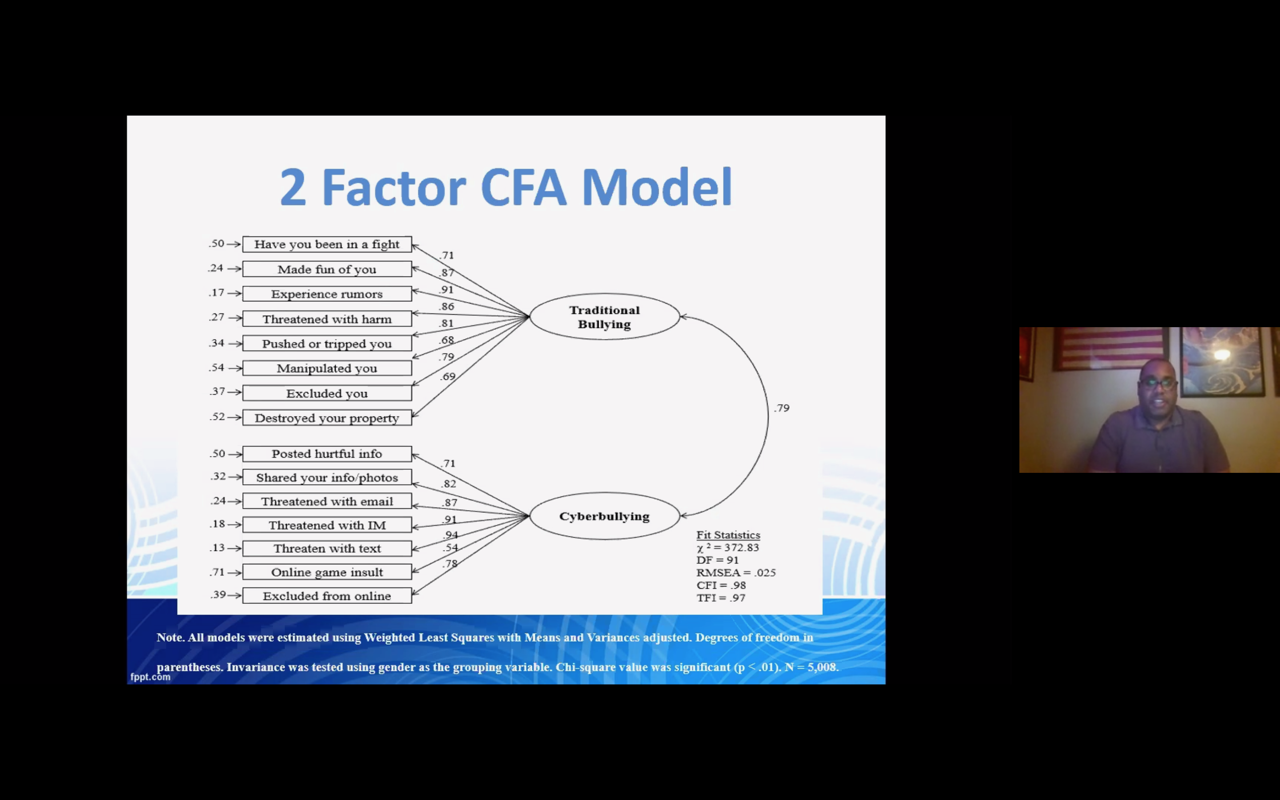
Dr. Betancourt presenting his 2 Factor CFA model of traditional bullying and cyberbullying during his virtual defense
Congratulations to Anthony Betancourt who recently successfully defended his dissertation titled “Understanding Gender Differences in Traditional and Cyberbullying: An Evaluation of Construct Validity of the 2013 School Crime Supplement to the National Crime Victimization Survey.” His psychometric analysis shows that cyberbullying is a separate factor from traditional bullying and should thus be viewed as a unique form of bullying.
Committee Members:
Dr. Bruce Homer, Chair, Executive Officer, Educational Psychology, GC CUNY
Dr. David Rindskopf, Professor, Educational Psychology, GC CUNY
Dr. Alpana Bhattacharya, Associate Professor, Educational Psychology, GC CUNY
Readers:
Dr. Jhan Berry, Executive Director, Educational Testing Service
Dr. Patrick Kyllonen, Distinguished Presidential Appointee, Educational Testing Service

Dr. Betancourt (bottom right) with his committee members and readers
Abstract:
Few measures assess cyberbullying and traditional bullying simultaneously while also reporting standards of reliability and validity. As a result, it remains unclear whether cyberbullying should be considered a separate type of bullying. This dissertation advances the literature by examining data from the 2013 School Crime Supplement to the National Crime Victimization Survey (NCVS-SCS) to provide psychometric information about the factor structure of the 2013 NCVS-SCS traditional and cyberbullying scales. Furthermore, the dissertation uses that information to evaluate if cyberbullying emerges as a unique factor. Finally, measurement invariance will determine if bullying holds the same meaning for boys and girls (e.g. are group comparisons valid).
Acceptable alpha coefficients were found for both scales. To evaluate the internal structure of the 2013 NCVS-SCS bullying scales, a two factor Exploratory Factor Analysis (EFA) was conducted. The EFA produced a good fitting model where cyberbullying items loaded onto one factor and traditional bullying items loaded on a second factor. Confirmatory factor analysis (CFA) further evaluated the factor structure by testing a model with two correlated latent factors (traditional and cyberbullying). The two factor CFA demonstrated acceptable levels of fit (c2 = 372.83; df = 91; p < .01; RMSEA = .025; CFI = .98; TFI = .97) and all items significantly loaded on their respective latent factor (p < .01). The model was determined to be invariant with respect to gender, as configural, metric, scalar, and full invariance was supported.
The results from this dissertation add to the limited number of studies reporting the psychometric properties of bullying measures capable of simultaneously measuring traditional and cyberbullying. The NCVS-SCS remains one of the few publicly available, nationally representative, measures of bullying behaviors. The CFA findings illustrate evidence of construct validity for the 2013 NCVS-SCS bullying scales, whose items are used to make the composites that provide national estimates of bullying. Meanwhile, the EFA results from this dissertation are in line with findings by Betancourt (2016) and Randa et al. (2015), providing further evidence that cyberbullying is a unique form of bullying and that it would be misguided for researchers to consider cyberbullying as a context or location for in-person forms of bullying. Limitations and future directions of this research are discussed, as bullying remains a problem for students and schools in the 21st century.




Congratulations, Dr. Betancourt!
Dr. Betancourt,
Congratulations on completing your dissertation. Your study is much needed. I hope you have plans to continue to study the validity of measures used in the School Crime Supplement to the National Crimes Victimization Survey. Cyber bullying is increasingly becoming a factor in youth suicide and mental illness. We need to be assured that the instruments used to measure it are valid and age appropriate and that the validity data are current since social media and, I believe, the hold it has on young people change rapidly and not for the better. I hope you will share the results of your study with the U.S, Department of Justice and encourage them to increase the number of items on the survey that deal with cyber bullying and bullying in general.